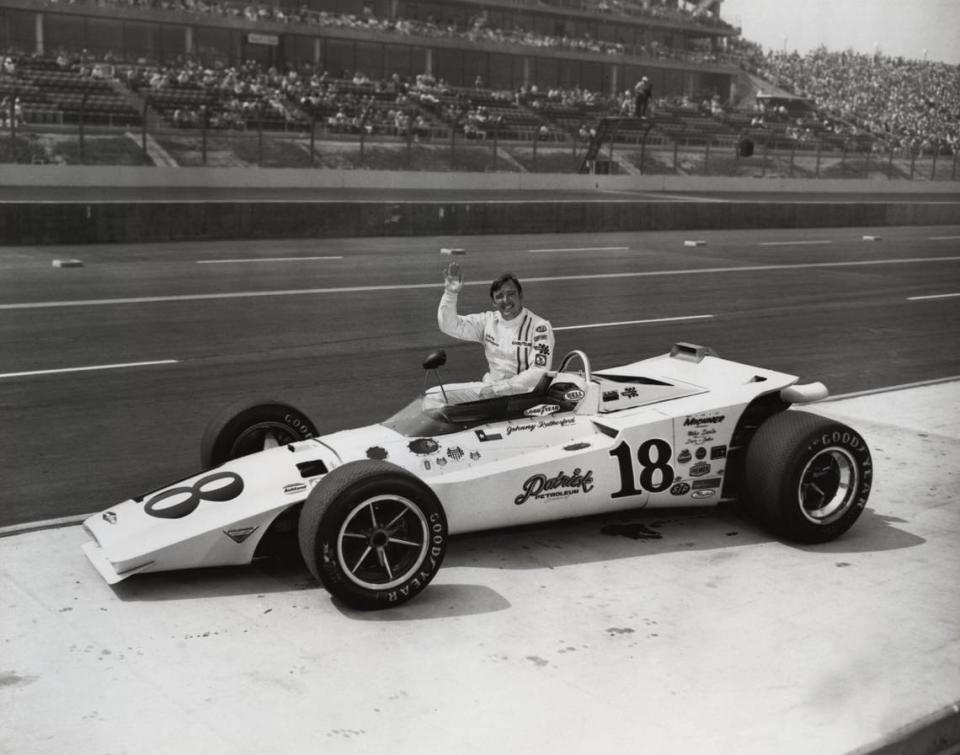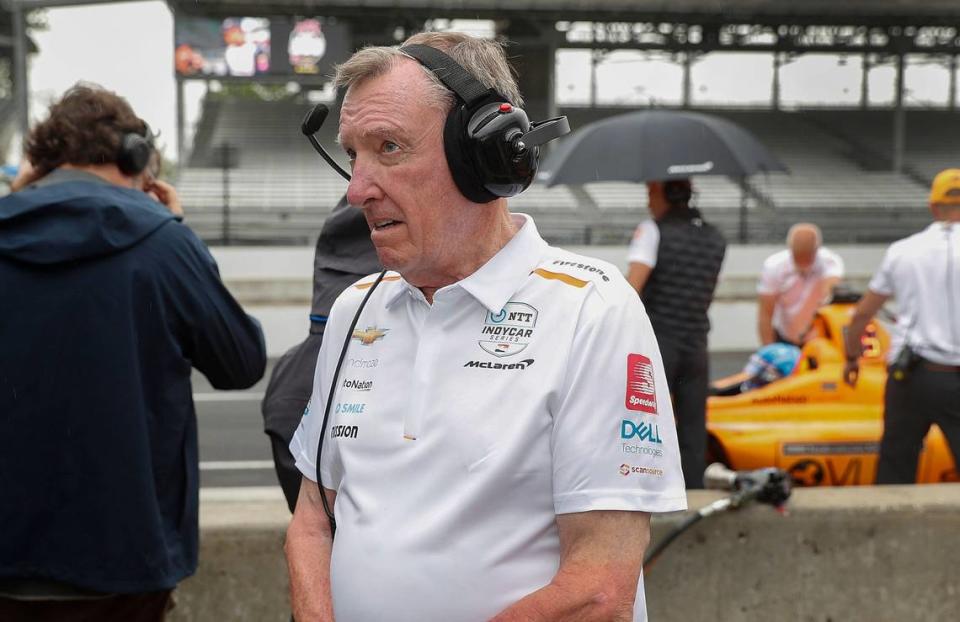Fort Worth’s Johnny Rutherford recalls first Indy 500 win, 50 years ago. ‘It’s been gratifying’
Fort Worth’s Johnny Rutherford has been scooting around the massive grounds of Indianapolis Motor Speedway this week in a golf cart. At age 86, it’s the perfect vehicle for transporting “Lone Star J.R.” down memory lane, 50 years after winning his first Indianapolis 500.
“Who keeps count?” Rutherford joked during a mid-week phone interview leading into Sunday’s 108th running of the Indy 500. “Numerically, it was 50 years ago and when you think about all the things that have happened, I’m glad that some people remember, you know? I hope so.”
Rutherford recorded his first of three Indy 500 victories in the event’s 58th edition on Sunday, May 26, 1974, in the No. 3 McLaren chassis powered by a 4-cylinder/turbocharged Offenhauser engine (he also won in 1976 and 1980). His annual drive from Fort Worth to Indy earlier this month brought with it the promise of a busier-than-usual schedule.
“It’s been great and hectical,” Rutherford said. “It’s been gratifying here because the fans … I can’t go anywhere on my golf cart that I don’t get stopped for an autograph as everybody kinda gathers around. There’s all sorts of things that people have wanted to do, McLaren and everybody. So, it’s been something — it really has. Just hard to remember … 50 years.”
Rutherford caught a glimpse of the low-slung No. 3 McLaren M16C — featuring his “Johnny Rutherford” signature in blue script on both sides of the cockpit — on Tuesday. The car has been a fixture at the Indianapolis Motor Speedway Museum.

“They had engine trouble with it (recently) and found another engine and changed the engine,” Rutherford said. “It’s going to be on display and then I think it will run with the other (vintage) cars on the track before the race.”
Arrow McLaren Sporting Director Tony Kanaan, the 2013 Indy 500 champion, is scheduled to drive the No. 3 car during the IMS Museum 500 Historic Car Lap. “I guess they don’t want to trust it to an 86-year-old driver,” Rutherford said. “They don’t care what his record is.”
Rutherford has remained in contact with the ownership and current drivers at Arrow McLaren through McLaren Racing CEO Zak Brown, a native Californian who was 2 years old when J.R. won the 1974 Indy 500. “Zak understands what I accomplished for McLaren, but it was a different group of people then,” said Rutherford, who grew up in Fort Worth and is a longtime resident of River Oaks.
McLaren Racing
The 1974 Indy 500 was Rutherford’s 11th start in “The Greatest Spectacle in Racing,” and second with McLaren Racing. Rutherford’s best finish in 10 previous Indy 500 attempts was ninth is his debut with McLaren in 1973. Rutherford’s career trajectory changed from journeyman to front-runner after he joined McLaren Racing, the organization founded in 1963 by driver/engineer Bruce McLaren of New Zealand. McLaren’s Papaya Orange race cars enjoyed success in the FIA’s Formula One World Championship and the Canadian-American Challenge Cup before heading to Indy in the late 1960s.
“They were dedicated racers. It was their business, racing cars, and I had driven for owners who it was their hobby,” said Rutherford, referring to McLaren founding partner and Team Manager Tyler Alexander; Teddy Mayer, managing director of McLaren’s F1 team and Patty McLaren, Bruce’s wife. “The three of them decided to keep the team going after Bruce McLaren died. You know … thank gosh.”
Bruce McLaren, 32, was killed in a crash while testing a new McLaren Can-Am car at the Goodwood Motor Circuit in Great Britain on June 2, 1970.
“Like I had told my wife, Betty, ‘If we ever find a team that loved racing as much as I did, I’ll be a winner,’^” Rutherford said. “And I found it with McLaren.”

Mayer signed Rutherford to his first McLaren contract as a “works” driver in the fall of 1972. As a factory driver, Rutherford was introduced to the McLaren M16C and its radical wedge-shaped nose, front wings and larger wing in the back.
Rutherford was paired with flamboyant teammate Peter Revson — heir to the Revlon cosmetics fortune — at IMS in 1973. Rutherford made headline news via his first Indy 500 pole with a track record, four-lap/10-mile average of 198.413 mph in the No. 7 Gulf McLaren/Offy.
“The M16 McLaren was the best flat-bottomed car to ever run the Indianapolis Motor Speedway,” Rutherford said, “and I took advantage of that.”
However, the M16 wasn’t a rocket out-of-the-box. “The car that Revvy drove … we tested that particular chassis at the Speedway in March (1973), I think, and it just had a terrible understeer, or pushed the front end (through the four turns, losing speed). We could not get it to stop. Tyler and I, over three days we changed everything but the paint job and could not get it to stop.
“Well, I didn’t know until years later what happened. They sent the car back to England and Gordon Coppuck, who designed the car, did some work on it. He changed the rear section on the car totally. They brought it back to the Speedway and we didn’t know what we had. And I went out and within five or eight laps I was running 200 mph (a 20 mph increase from the March test). It was a jaw-dropper. The thing was just incredible. It was so stable at the speed, it was really something to drive. And it was from that point on that we had success with the car.”

Remembering ‘74 Indy 500
Rutherford’s ninth-place finish at Indianapolis Motor Speedway in 1973 placed him among the pole favorites the following May. However, Houston native A.J. Foyt Jr. — then a three-time Indy 500 winner — qualified P1 by averaging 191.632 mph in his No. 14 Gilmore Racing Team Coyote/Foyt.
“We knew we had a very fast race car because we were prepared to challenge Foyt for the pole,” Rutherford said. “I think we would have won the pole position but for a technical situation with Chief Steward Tom Binford, who was new that year. We had engine trouble in the practice warmup for Pole Day and the guys went back and changed the engine and got it ready. We came back out to qualify and Binford said, ‘You guys weren’t here when we called for the lineup, so you’ve got to go to the end of the line.’ ”
That circumstance forced Rutherford to qualify on Day 2 of time trials, during which he secured the 25th starting spot at 190.446 mph. “I started 25th but I had second-fast time in the car and actually probably the fastest time,” said Rutherford, who lined up in Row 9. “They dropped the green flag for the start and in 23 laps I was running third. So my car was definitely very good.”
Rutherford passed Bobby Unser for second on Lap 24 in pursuit of Foyt. J.R. took the lead from Foyt on Lap 65 and held it through Lap 125. The two Texans swapped the lead between Laps 126 and 140, when Foyt’s Poppy Orange car was black-flagged for dropping oil on the track. After a broken oil fitting officially eliminated “Super Tex” on Lap 142, Rutherford led all but one of the remaining 58 laps. He averaged 158.589 mph en route to finishing a comfortable 22.32 seconds in front of runnerup Unser and his No. 48 Olsonite Eagle/Offy.

Charting those tenths-of-seconds was the job of Betty Rutherford, who had begun timing-and-scoring each of her husband’s laps with a stopwatch in 1973. “They had the official timing-and-scoring with the sanctioning body (U.S. Auto Club), but Betty also kept it so we could compare,” Rutherford said. One of the first women to break the gender barrier in the pits at Indy, Betty continued those duties for more than 20 years. Mrs. Rutherford died on Jan. 20, 2019, at age 80.
“It was just another race day for us,” said J.R., whose victory in 3 hours, 9 minutes and 10.06 seconds was worth $245,032. “Get the job done.”
That win began a stretch at Indianapolis Motor Speedway that saw Rutherford finish 1-2-1 through 1976 with McLaren, which exited IndyCar at the end of the 1979 season to concentrate on its F1 program.
“I was there seven years with Tyler Alexander and Teddy Meyer ... a good group,” Rutherford said. “I won two of my Indy 500s (1974, 1976) with McLaren. It was a good experience for me, for sure, to have winning cars and to set fast time and do whatever was needed of us — we did. I did the whole spectrum. That’s the way racing is … chicken one day, feathers the next. It happens to everybody.”
Former Star-Telegram sports/motorsports beat writer John Sturbin has been covering the Indianapolis 500 since 1980. A staffer on the Race Day San Antonio website (racedaySA.com), his email address is jsturbin@hotmail.com.

 Yahoo Sports
Yahoo Sports 